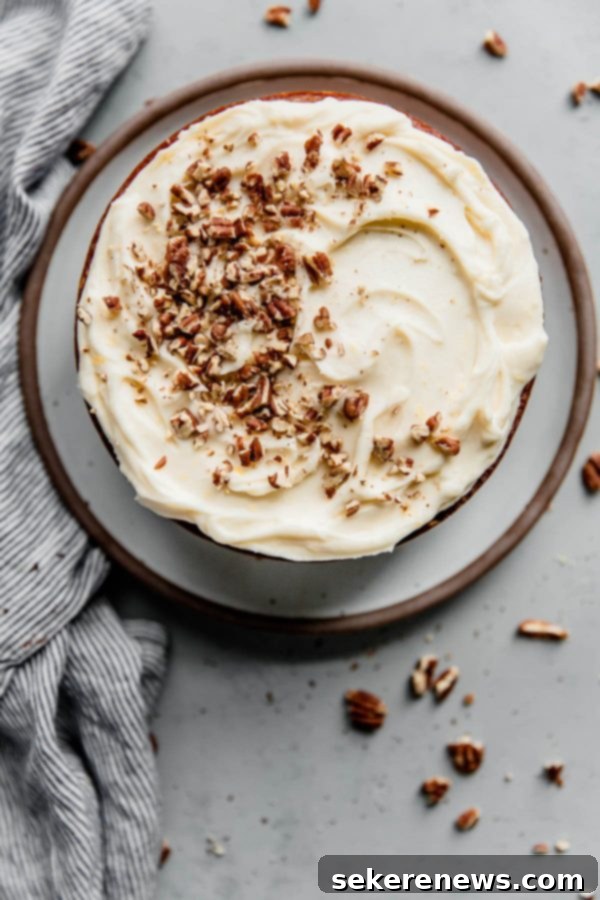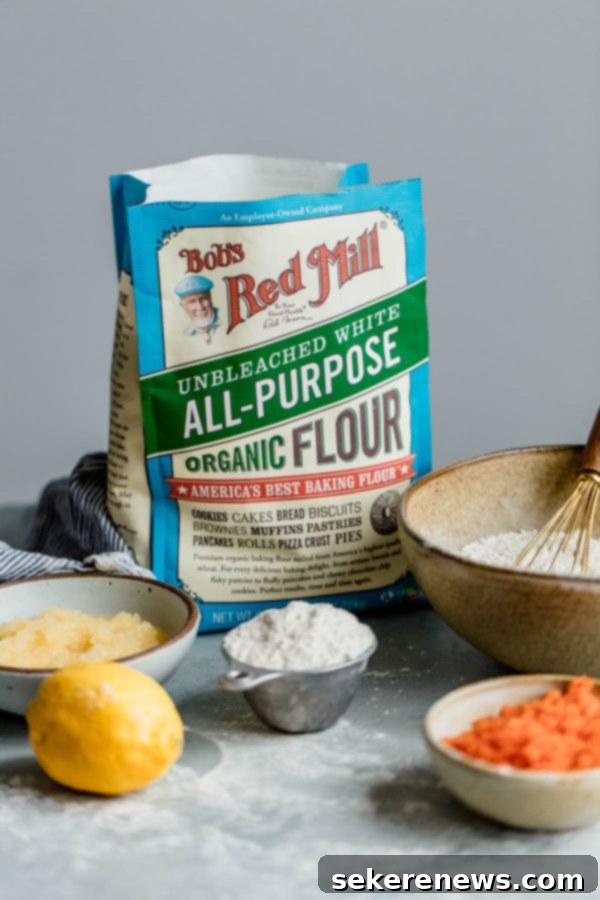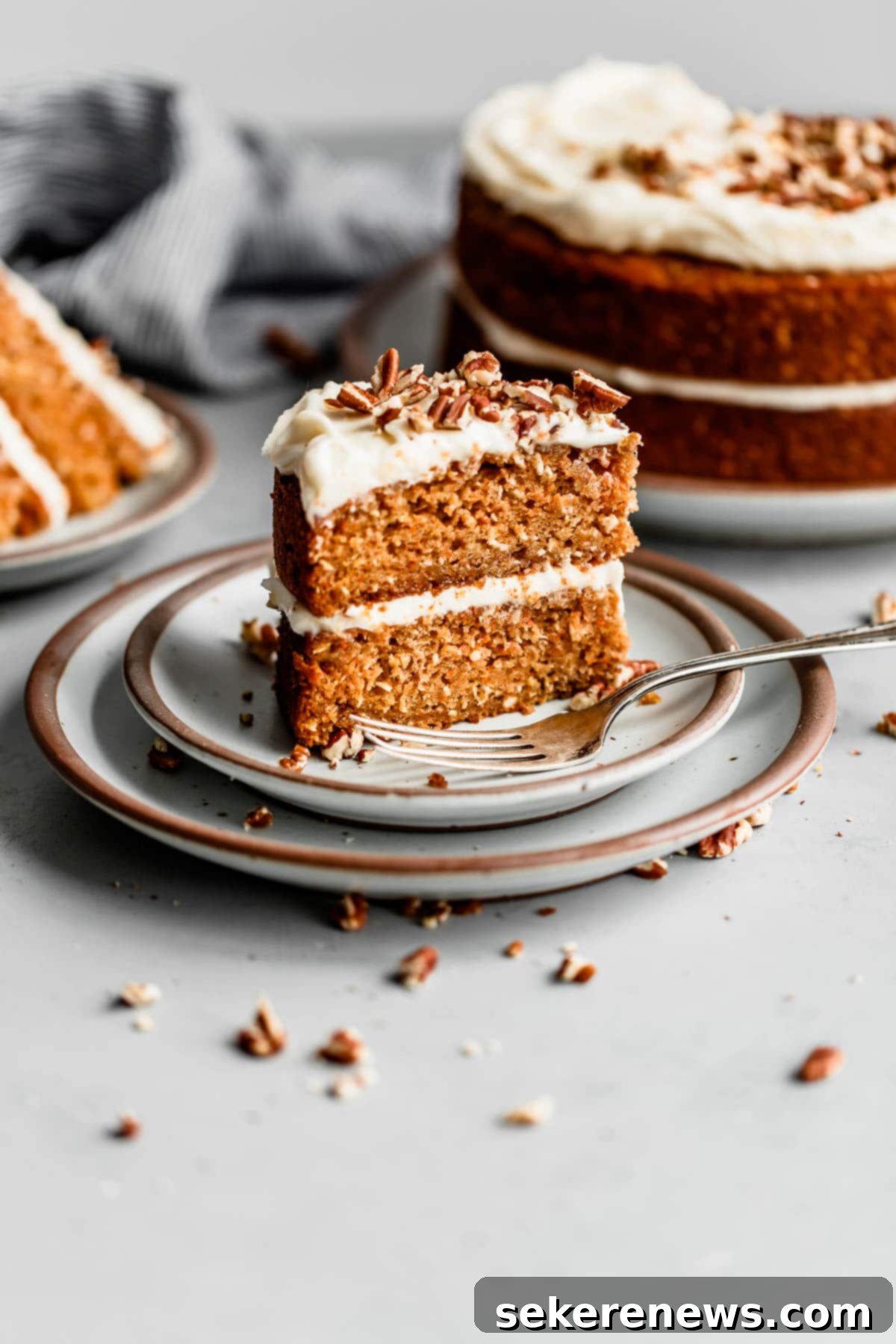The Ultimate Moist Carrot Cake with Pineapple, Coconut, and Zesty Lemon Cream Cheese Frosting
This exceptional carrot cake, featuring the delightful additions of crushed pineapple and shredded coconut, promises an incredibly moist texture and a beautifully balanced, lightly spiced flavor. It’s remarkably easy to prepare, making it a perfect dessert for special occasions like Easter weekend, or simply to brighten any day of the year. Get ready to bake a new favorite (and don’t miss the recipe video below for a visual guide)!

After a short hiatus, I can think of no better way to return than with a show-stopping cake. And not just any cake – we’re talking about a truly exceptional carrot cake with lemon cream cheese frosting! If you’re searching for a delicious, classic dessert recipe that will impress your guests, especially for Easter weekend or any festive gathering, your search ends here. My journey with carrot cake is a long and flavorful one.
In fact, when crafted with care and the right ingredients, carrot cake stands as one of my all-time favorite desserts. There’s something undeniably comforting and delightful about its spiced sweetness, especially when spring arrives and fresh carrots are abundant. It’s a dessert that perfectly bridges the gap between seasons.
My love for this humble vegetable in dessert form isn’t new. A few years ago, I delighted in sharing these irresistible carrot cake scones, and just last year, we whipped up some wholesome carrot cake breakfast cookies. Today, however, I’m returning to the essence of what makes carrot cake truly special, sharing my absolute favorite, tried-and-true recipe that combines traditional flavors with delightful twists.

Why You’ll Fall in Love with This Carrot Cake Recipe
This carrot cake isn’t just a dessert; it’s an experience. It’s engineered to be exceptionally moist – a quality attributed to a few secret ingredients we’ll explore shortly. Each bite is rich with freshly grated carrot, perfectly balanced by a medley of warm spices, and incredibly easy to prepare from start to finish. The result is a homemade cake that tastes like it came from a gourmet bakery.
Beyond its irresistible flavor, one of the best features of this recipe is its impressive durability. This cake holds up extraordinarily well, meaning you can bake and assemble it days in advance without compromising freshness or taste. This makes it an ideal choice for busy holiday preparations, allowing you to enjoy your celebration without last-minute baking stress. The leftovers, if there are any, will remain delicious for days, perhaps even improving in flavor as the ingredients meld together.
In keeping with cherished tradition, this magnificent cake is crowned with a luscious, tangy cream cheese frosting. For me, carrot cake simply isn’t complete without it. I’ve elevated this classic frosting by incorporating fresh lemon zest, which introduces a wonderful brightness and a subtle citrus note. This zesty addition beautifully complements the inherent sweetness and spices of the carrot cake, creating a harmonious flavor profile that is truly unforgettable.
You have the flexibility to present this cake in your preferred style: a rustic “naked cake” with exposed sides revealing its beautiful layers, or fully decorated with generous swirls of frosting. The provided frosting recipe yields ample amounts to accommodate both options, ensuring you have enough to create your desired look. This recipe is designed to produce a substantial 8-inch, two-layer cake, offering approximately 10 to 12 generous portions – perfect for sharing.
For an added layer of texture and a nutty crunch, I love to garnish the top of the cake with toasted, coarsely chopped pecans. If pecans aren’t to your liking, feel free to substitute them with chopped walnuts, or omit nuts entirely for a nut-free version of this delectable dessert. The versatility of this recipe ensures everyone can enjoy a slice of perfection.

The Foundation of Flavor: Quality Flour Matters
For this delightful carrot cake recipe, I consistently turn to my trusted and highly reliable everyday baking flour: Bob’s Red Mill Organic Unbleached All-Purpose Flour. Having collaborated with Bob’s Red Mill for over four years, I can wholeheartedly recommend their exceptional products for all your baking needs. Their commitment to quality truly shines through in every bake.
Bob’s Red Mill Organic Unbleached All-Purpose Flour is meticulously crafted from freshly milled organic hard red wheat. This particular flour boasts a moderate protein content, typically between 10% and 12%. This mid-range protein level is absolutely ideal for cakes like our carrot cake, as it allows for a wonderfully tender and delicate crumb while simultaneously providing enough structure and gluten development to ensure the cake holds its shape beautifully. It strikes the perfect balance, preventing the cake from becoming too dense or too crumbly.
I always ensure I have this versatile flour on hand in my pantry because its consistent performance makes it suitable for such a wide array of baking applications, from cakes and cookies to breads and pastries. It delivers reliable, consistent results every single time, giving me confidence in my baking.
Equally important to me, and a defining characteristic of Bob’s Red Mill, is their unwavering dedication to natural ingredients. Their flours are never bleached and contain absolutely no bromate (a chemical banned in many countries outside the United States) or any other harsh chemicals. This commitment to purity ensures that you’re baking with the highest quality, most natural ingredients. If you’re curious to learn more about the science and artistry behind various flours, you can delve deeper into the different types of baking flour here.

The Distinctive Difference: Pineapple and Coconut in Carrot Cake
So, what truly sets this carrot cake recipe apart from the rest?
It’s not just a subtle variation; this cake offers a delightful departure from overly sweet, one-note carrot cakes. It achieves a perfect balance of sweetness and tang, thanks to the inclusion of fresh lemon zest in both the cake and the frosting. But the real game-changers are the abundant, freshly grated carrots, coupled with a generous amount of crushed pineapple and unsweetened shredded coconut. These ingredients aren’t just add-ons; they are integral to the cake’s unique character and incredible moisture.
The idea of adding pineapple to carrot cake can sometimes be a point of debate among purists, but I assure you, once you experience the transformation it brings, you’ll be a firm convert. The crushed pineapple is not only a fantastic natural sweetener but, more importantly, it injects an unparalleled level of moisture and a subtle tanginess into the cake. It makes the cake incredibly tender and prevents it from drying out, even days after baking. Trust me, it adds a truly special dimension that you won’t want to bake without again. Promise.
Key Tips for Carrot Cake Success:
Achieving the perfect carrot cake is all about understanding how each ingredient contributes to the final masterpiece. Here are my essential tips to ensure your cake is nothing short of perfection:
- Avocado (or Neutral Vegetable) Oil: For cakes that are rich in other flavorful ingredients, such as this carrot cake, I consistently prefer to use oil as my primary baking fat instead of butter. Oil is superior in producing a beautifully moist cake crumb that remains tender and delicious for an extended period. My preference is avocado oil due to its excellent nutritional profile, neutral flavor (which allows the other ingredients to shine), and high smoke point. However, any other neutral-flavored vegetable oil, like grapeseed or canola oil, will work as a substitute, delivering similar moist results.
- Finely Grated Carrot: This recipe calls for a substantial 2½ cups of finely grated carrot, which typically amounts to about 4-5 large carrots. The quickest and most efficient method for grating carrots is to use the grating blade attachment of a food processor. To achieve an even finer grind and ensure the carrots meld seamlessly into the cake batter (rather than creating coarse pieces), I recommend pulsing the coarsely grated carrots several times in the food processor bowl with the blade attachment. This finer texture is crucial; it contributes significantly to a lighter, more delicate cake crumb and ensures moisture is evenly distributed.
- Drained Crushed Pineapple: The crushed pineapple is a star ingredient, offering not just an incredible boost of moisture but also a subtle acidity that brightens the cake’s overall flavor profile. For this recipe, you’ll need one cup of drained canned crushed pineapple (packed in its own juice, not heavy syrup). A fine-meshed sieve is your best friend here for thoroughly draining the liquid. To take it a step further and ensure uniform distribution throughout the cake batter without any surprising lumps, we’ll pulse the drained pineapple in a food processor until it reaches a smooth, applesauce-like consistency. This meticulous preparation ensures every bite of your cake is consistently moist and flavorful.
- Unsweetened Shredded Coconut: This ingredient is more than just a garnish; it’s a key player in the cake’s nuanced flavor and texture. Unsweetened shredded coconut imparts a delicate hint of natural coconut flavor that perfectly complements the warm spices, vibrant carrots, and tangy pineapple. It also adds a lovely, tender chewiness, enhancing the overall sensory experience of the cake. Opting for unsweetened coconut prevents the cake from becoming overly sweet, maintaining that delightful balance.
Pro-Tip: For enhanced visual clarity on how to perfectly prepare these crucial ingredients, be sure to watch the comprehensive recipe video provided below.

Over the years, I’ve experimented with various carrot cake iterations – with nuts, raisins, and every possible combination. However, I can definitively say that carrot cake with pineapple and coconut has emerged as my absolute, unrivaled favorite. The combination of these specific ingredients elevates the classic to a truly extraordinary level.
The crumb of this carrot cake is exquisitely tender and wonderfully moist, boasting a delicate texture thanks to the finely grated carrots and the subtle chewiness of the coconut. While the lemon cream cheese frosting undeniably propels it to another level of indulgence, I must emphasize that this cake is so remarkably flavorful and moist that it tastes absolutely fantastic even on its own. It’s truly a testament to the quality of the ingredients and the careful preparation.
Furthermore, this cake strikes the perfect balance of sweetness. It’s sweet enough to satisfy any dessert craving, yet it avoids being overly rich or heavy. This ensures that the delightful, tangy cream cheese frosting complements rather than overwhelms the cake, allowing both components to shine harmoniously. Each bite offers a symphony of flavors and textures, making it a dessert you’ll crave repeatedly.


Carrot Cake with Lemon Cream Cheese Frosting
Pin
Review
SaveSaved!
Important Note on Pineapple Preparation: For the smoothest texture and to ensure the pineapple’s crucial moisture is evenly distributed throughout the cake batter without resulting in a coarse crumb, pulsing the thoroughly drained crushed pineapple in a food processor until it reaches a thick applesauce-like consistency is key. You’ll need just under one standard 20-ounce can of crushed pineapple, packed in its own juice, to achieve the ideal quantity specified in this recipe.
Equipment
-
Williams Sonoma Goldtouch® 8-Inch Nonstick Round Cake Pan (two needed for a two-layer cake)
-
Magimix Food Processor (highly recommended for grating carrots and pulsing pineapple)
-
Large Mixing Bowls
-
Whisk and Spatula
-
Stand Mixer with Paddle Attachment (for frosting)
Ingredients
For the Carrot Cake:
- 2 cups (260g) Bob’s Red Mill Organic Unbleached All-Purpose Flour
- 1¾ teaspoons baking soda
- 2 teaspoons ground cinnamon
- 1 teaspoon ground ginger
- ¾ teaspoon kosher salt
- 1¼ cups (250g) granulated sugar
- zest of 1 lemon
- 4 large eggs at room temperature for best emulsion
- ½ cup (120 mL) avocado or other neutral vegetable oil
- 1 cup (225g) drained canned crushed pineapple, then pulsed in food processor until it reaches the consistency of thick applesauce *you will need just under one (20-ounce) can
- 2 teaspoons pure vanilla extract
- 2½ cups (315g) finely grated carrot (about 5-6 large peeled carrots) I use my food processor grating blade to grate, then pulse the grated carrots in a food processor to get a finer grind
- ½ cup (50g) Bob’s Red Mill unsweetened shredded coconut
For the Lemon Cream Cheese Frosting:
- 8 ounces (224g) full-fat block cream cheese softened to room temperature
- ¾ cup (6 oz; 170g) unsalted butter softened to room temperature
- ⅛ teaspoon kosher salt
- 1 teaspoon pure vanilla extract
- zest of 1 lemon
- 2¼ cups (270g) powdered sugar sifted to remove any lumps, essential for a smooth frosting
For Garnishing:
- toasted pecans (optional) coarsely chopped for added crunch and flavor, or use walnuts
Instructions
-
Critical Baking Note: Before you begin, please thoroughly review the specific preparation methods for both the crushed pineapple and finely grated carrot detailed in the ingredient list above and the “Tips for Success” section. Proper preparation of these ingredients is crucial for the cake’s ultimate moistness and texture.
-
1. Prepare the Cake Pans and Oven: Preheat your oven to 350°F (180°C), ensuring the oven rack is positioned in the center. Prepare two 8-inch (20cm) round cake pans by generously greasing them with baking spray or butter, then line the bottoms with a round of parchment paper. This prevents sticking and ensures easy release. Set the prepared pans aside.
-
2. Combine Dry Ingredients: In a medium-sized mixing bowl, whisk together the Bob’s Red Mill organic unbleached all-purpose flour, baking soda, ground cinnamon, ground ginger, and kosher salt until thoroughly combined. This ensures the leavening and spices are evenly distributed. Set this dry mixture aside.
-
3. Prepare Wet Ingredients: In a large mixing bowl, combine the granulated sugar and lemon zest. Using your fingertips, vigorously rub the lemon zest into the sugar for about 1 minute. This crucial step releases the fragrant essential oils from the zest, infusing the sugar with intense lemon flavor and making it wonderfully moist. Next, add the room-temperature eggs, avocado (or neutral vegetable) oil, the puréed crushed pineapple, and pure vanilla extract. Whisk the mixture until it is completely smooth and appears thick and creamy, ensuring all ingredients are well emulsified.
-
4. Combine Wet and Dry Mixtures: Gradually add the prepared dry flour mixture to the wet ingredients in two additions. Using a stiff whisk or sturdy spatula, gently combine until the flour has just been absorbed and no dry streaks remain. Be extremely careful to avoid overmixing at this stage, as over-developed gluten can lead to a tough cake. Finally, fold in the finely grated carrot and unsweetened shredded coconut with a spatula until evenly distributed. Again, avoid overmixing.
-
5. Bake the Cake Layers: Divide the cake batter evenly between the two greased and parchment-lined cake pans. Use an offset spatula to gently smooth the top of the batter in each pan. Bake for 32 to 38 minutes, or until the cakes achieve a beautiful golden-brown color, the edges begin to slightly pull away from the sides of the pan, and a wooden toothpick inserted into the center comes out clean or with only a few moist crumbs attached.
-
6. Cool the Cake: Allow the freshly baked cake layers to cool in their pans on a wire cooling rack for approximately 10 minutes. This initial cooling helps them firm up. Then, carefully invert the cakes onto the cooling rack, remove the parchment paper from the bottoms, and invert them once more so that the top of each cake layer is facing upward. Allow the cake layers to cool completely to room temperature before attempting to frost them. *Advance Preparation Note: If you plan to bake the cake layers ahead of time, ensure they are completely cool, then wrap each layer tightly with plastic wrap and refrigerate for up to 2 days, or freeze for up to 2 months. Thaw frozen layers at room temperature for 12-24 hours before assembling.
-
7. Prepare the Lemon Cream Cheese Frosting: In the bowl of a stand mixer fitted with a paddle attachment, combine the softened full-fat block cream cheese, softened unsalted butter, kosher salt, pure vanilla extract, and fresh lemon zest. Beat these ingredients together on medium-high speed until the mixture is beautifully smooth and creamy, which typically takes about 30 seconds to 1 minute.
-
8. Finish the Frosting: With the mixer on low speed, gradually add the sifted powdered sugar. Start slowly to avoid a sugar cloud. Once the powdered sugar has been mostly incorporated, increase the mixer speed to medium-high and continue beating until the frosting is light, smooth, and fluffy, usually within about 1 minute. Pause once or twice during this process to scrape down the bottom and sides of the bowl with a spatula, ensuring all ingredients are fully combined and there are no hidden lumps.
-
9. Assemble the Cake: Carefully choose the sturdiest and most even cake layer to be the bottom of your cake, and place it onto a cake stand or serving board. Evenly spread a generous layer of the lemon cream cheese frosting over the top of the first cake layer. Gently place the second cake layer on top. Spread the remaining frosting over the top layer, using a small offset spatula to create elegant little swooshes or a smooth finish, as desired. Frosting Coverage Note: This cream cheese frosting recipe provides enough frosting to cover both the tops and the sides of the cake. Alternatively, you can opt for a “naked cake” look, leaving the sides exposed to showcase the moist cake layers – a beautiful and equally delicious presentation.
-
10. Garnish and Serve: Garnish the top of the cake with coarsely chopped toasted pecans or walnuts, if desired, for an extra layer of flavor and texture. Slice with a sharp, warm knife for clean cuts and serve. If preparing the cake ahead (which is highly recommended to allow flavors to meld), cover it loosely and refrigerate for up to 2 days. While the cake is best served within a day or two of baking, its high moisture level ensures it holds up exceptionally well and remains delicious for 3 to 5 days after baking when properly stored. Serving Tip: If serving from the refrigerator, I prefer to remove the cake about 30 minutes before serving. This allows the cake and frosting to come to a slightly cooler room temperature, which I find enhances the flavors and texture of both the carrot cake and the creamy frosting. Enjoy!
Video
Additional Tips for Success:
- Pulsing the thoroughly drained crushed pineapple is a game-changer. It creates an incredibly smoother texture within the cake and ensures that the vital moisture and tangy flavor from the pineapple are perfectly and evenly distributed throughout the cake batter, without leading to an undesirable coarser cake texture or noticeable chunks. You’ll need just under one standard 20-ounce can of crushed pineapple (packed in juice) to get the specified quantity for this recipe.
- For the absolute best texture in your carrot cake, I strongly recommend grating your carrots using the grating blade of a large food processor (or, if a food processor isn’t available, a fine box grater). After grating, take an extra step: pulse the grated carrot a few times in the food processor bowl (with the standard blade attachment) to achieve an even finer grind. This fine texture is key to a light, moist, and tender cake crumb.
- If you’re planning ahead and wish to prepare the cake layers in advance, allow them to cool completely after baking. Once cooled, wrap each layer very tightly with plastic wrap to prevent any moisture loss. They can then be refrigerated for up to 2 days or frozen for up to 2 months. If frozen, ensure you allow the cake to thaw completely at room temperature for 12 to 24 hours before you plan to assemble and frost it. While this cake is undeniably best enjoyed within a day or so of baking, its inherent high moisture level means it holds up exceptionally well and maintains its delicious flavor for a good 3 to 5 days after baking when stored correctly.



